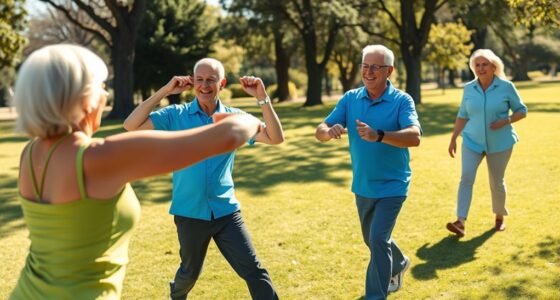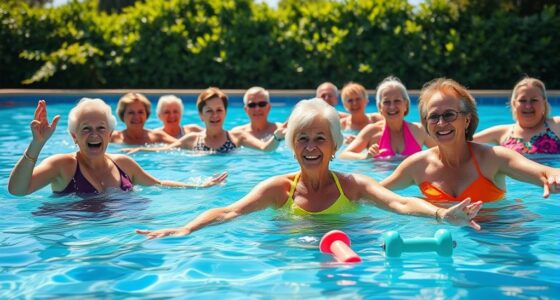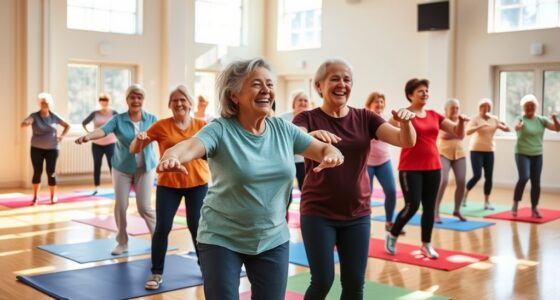Strength building exercises are crucial for your daily energy and independence as a senior. Focusing on strength training helps combat sarcopenia, improve bone density, and enhance balance, which reduces fall risk. Start with bodyweight exercises, then progress to light weights, like squats, incline pushups, and seated rows. Remember to maintain proper form and consider modifications for safety. With regular practice, you’ll notice improvements in mobility and mental health—plus, there’s more to discover!
Key Takeaways
- Prioritize bodyweight exercises like squats and incline pushups to build foundational strength safely.
- Incorporate two strength training sessions weekly to enhance mobility and overall health.
- Utilize modifications, such as a chair for support during squats, to ensure safety and effectiveness.
- Stay hydrated and maintain a balanced diet to fuel and support your strength training efforts.
- Engage in balance exercises, like tai chi, to improve coordination and prevent falls.
Importance of Strength Training for Seniors
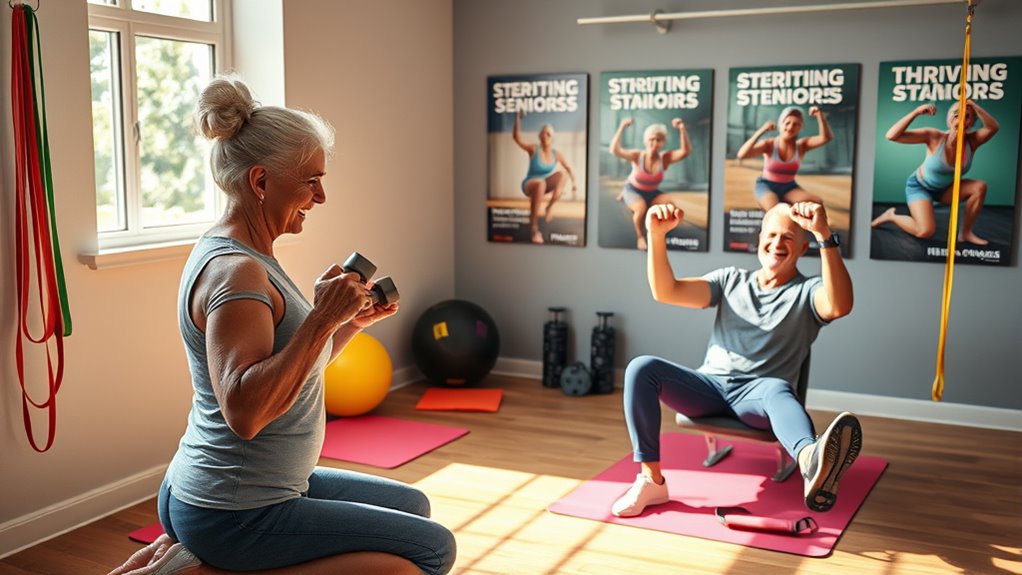
As you age, it’s essential to prioritize strength training, not just for muscle maintenance but also for your overall health. Engaging in strength exercises for older adults combats sarcopenia, the natural loss of muscle mass, enhancing your strength and mobility. Additionally, maintaining involvement in physical activities can significantly contribute to mental well-being as you grow older. Regular physical activity helps protect energy and fosters resilience, enabling you to better navigate life challenges. Incorporating emotional regulation strategies during workouts can further enhance your overall well-being.
Improved bone density through these exercises greatly reduces the risk of osteoporosis and fractures, helping you stay independent. Regular strength training also boosts your functional fitness, making daily activities like bathing and cooking easier. Furthermore, cognitive decline can be mitigated by engaging in regular physical exercises, promoting better mental acuity as you age.
Beyond physical benefits, strength training positively impacts mental health by alleviating symptoms of depression and anxiety. These exercises can also foster a sense of accomplishment, which is crucial for emotional stability during life transitions.
Finally, these exercises help prevent falls by improving balance and coordination, ensuring you maintain your independence as you age. Embrace strength training for a healthier, more active life! Additionally, creating living spaces that enhance quality of life can further support your strength training efforts.
Getting Started With Strength Training
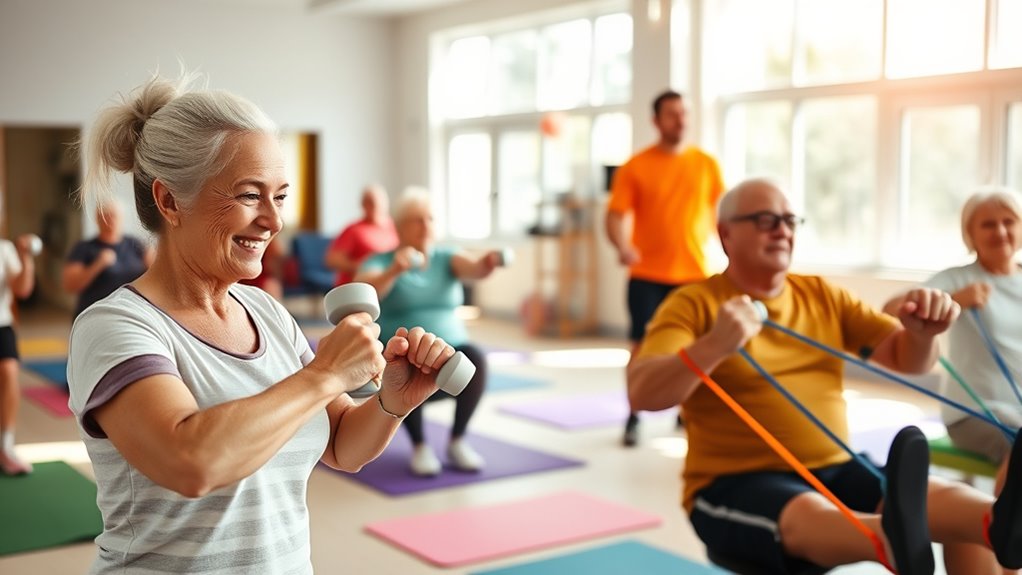
Starting strength training can feel challenging, but it’s an important step toward maintaining your health and independence.
Begin with bodyweight exercises, aiming for three sets of 10 to 15 repetitions to build a foundation of strength and proper form. Once you find these manageable, progress to using light weights or resistance bands. Engaging in educational and skill-building toys can help improve coordination and strength in a fun way. Attention to detail in your form during exercises is crucial for preventing injuries and maximizing benefits. Regularly practicing mindfulness techniques can also enhance your focus during workouts, leading to better results. Additionally, incorporating sustainable fashion principles into your workout gear can motivate you to engage in physical activity more often.
Schedule at least two strength training sessions per week, allowing for rest days to aid recovery. Focus on key exercises like squats and incline pushups to target various muscle groups, enhancing your ability to perform daily activities and reducing fall risk. Engaging in regular exercise is critical for maintaining a healthy weight and preventing behavioral issues.
If you’re unsure where to start, consulting a personal trainer can help tailor a routine to your health condition, ensuring a safe and effective approach to regular strength training.
Key Strength Exercises for Older Adults
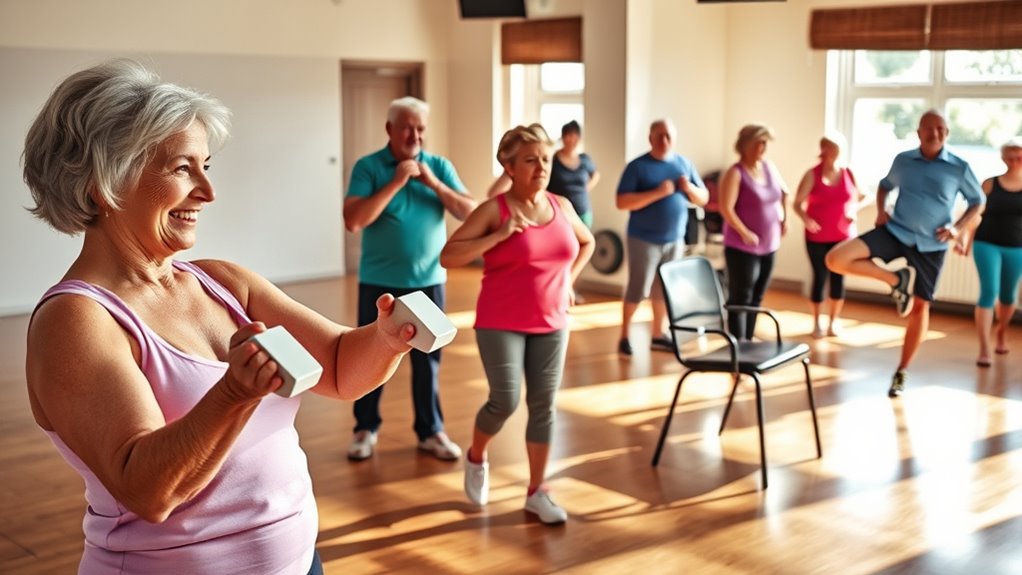
When it comes to building strength, there are essential exercises you should focus on, like squats and incline pushups. It’s vital to master proper form to prevent injury, and modifications can help you stay safe while progressing. Incorporating regular physical activity can significantly enhance your fitness and overall well-being. Additionally, engaging in strength-building exercises can lead to improved muscle mass and better mobility as you age. As you practice these exercises, remember the importance of high vibrational energy in maintaining motivation and enhancing your overall experience. This consistent effort can help you develop a budget for your fitness journey, ensuring you allocate time and resources effectively. Let’s explore these key strength exercises to enhance your fitness and overall well-being.
Essential Strength Exercises
A variety of essential strength exercises can greatly enhance your fitness as you age. Incorporating these key movements into your routine can improve muscle strength for daily activities and overall functional fitness. Here’s a quick overview:
| Exercise | Benefits | Reps |
|---|---|---|
| Squats | Improves leg strength and mobility | 10-15 |
| Incline Pushups | Builds upper body strength | 10-15 |
| Seated Rows | Strengthens back and improves posture | 10-15 |
| Stationary Lunges | Enhances balance and stability | 10-15 |
| Dead Bug | Boosts core stability and coordination | 10-15 |
Additionally, maintaining physical activity can help prevent permanent hearing loss and other age-related conditions. Engaging in regular exercise can also foster a sense of community support which is vital for emotional well-being in seniors.
Proper Form Techniques
Incorporating proper form techniques into your strength exercises is essential for maximizing benefits and minimizing injury risk as you age. Here are some key points to remember:
- Maintain a straight back during squats to guarantee safety and effectiveness. Additionally, focusing on cognitive function can enhance your overall exercise performance. Regular strength training can also improve overall pet health by promoting physical activity and mobility in older adults. Understanding the implications of state tax laws on retirement income can also help you plan for a financially secure future. It’s important to consider how advance directives can ensure your health care preferences are honored as you engage in physical activity.
- Engage the core while performing the dead bug exercise, keeping your back flat against the floor for stability.
- In seated rows, keep your shoulders down and back, pulling the resistance band towards your abdomen to effectively target the upper back.
- For stationary lunges, confirm your front knee stays directly above the ankle to engage the correct muscle groups and reduce the risk of injury.
Additionally, consider incorporating regular vocal warm-ups to prepare your body and prevent strain during exercises.
Modifications for Safety
Modifications for strength exercises aren’t just helpful—they’re essential for ensuring safety and effectiveness as you age. These adjustments can markedly reduce the risk of injury while helping you build strength.
For example, in the Dead Bug exercise, keeping your legs bent makes it easier to manage if you have limited core strength. Adjusting the incline during Incline Pushups accommodates different fitness levels, keeping the exercise accessible yet challenging. Regular cleaning of the cage is essential to prevent odor and disease during your exercise routine. Additionally, ensuring that your exercise area is free from clutter can help prevent falls and injuries, which is especially important for older adults. Practicing mindfulness techniques can further enhance your awareness and focus during workouts.
When doing Seated Rows with resistance bands, make sure the band is securely anchored to prevent slipping. To enhance stability during Stationary Lunges, use a chair for support, which allows you to focus on maintaining proper form and balance. Incorporating fresh orange juice into your diet can provide essential vitamins that support overall health during your exercise routine.
These simple modifications can greatly improve your exercise experience.
Additional Considerations for Seniors
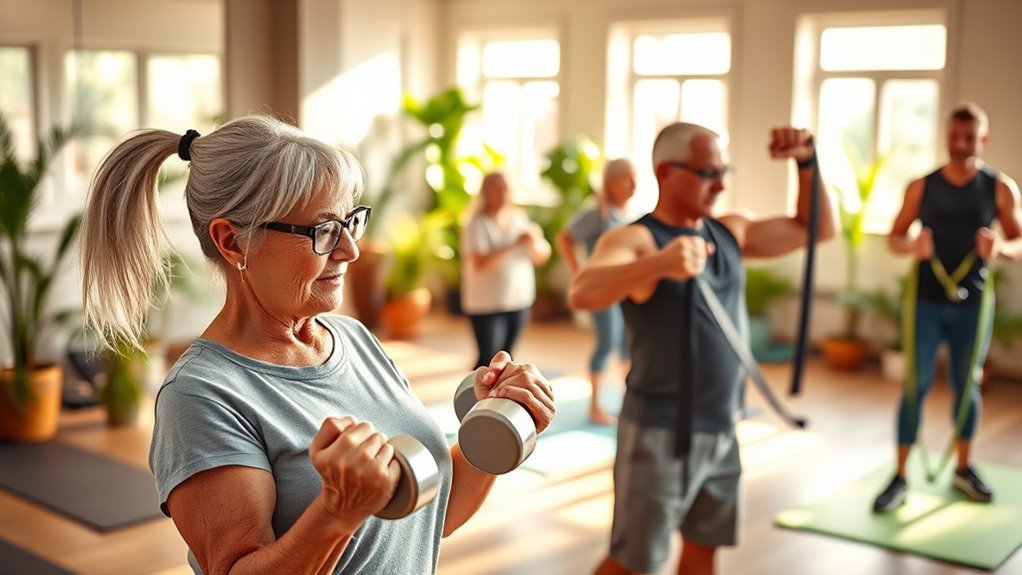
While strength training is essential for seniors, there are additional considerations to keep in mind to guarantee safety and effectiveness.
Here are some tips to help you thrive:
- Warm-Up and Cool-Down: Always start with warm-up exercises and finish with cool-down routines to protect your muscles and back.
- Stay Hydrated: Drink enough water during and after exercise to prevent muscle cramps and promote overall health.
- Choose a Sturdy Chair: Use a sturdy chair for seated exercises, ensuring your feet are flat on the ground for stability.
- Incorporate Balance Exercises: Activities like tai chi can reduce stress and enhance coordination, lowering the risk of falls.
Building Strength and Independence
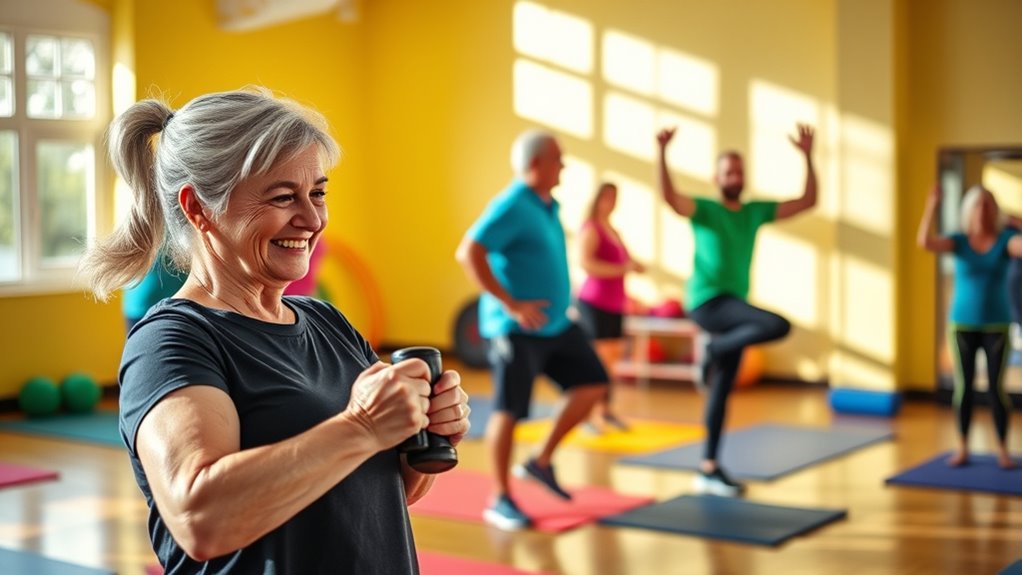
Building strength not only enhances your physical capabilities but also plays an essential role in maintaining your independence. By engaging in regular strength training, you improve your mobility and stability, making daily activities like bathing, dressing, and cooking easier.
As an older adult, combatting sarcopenia—the age-related loss of muscle mass—is vital for reducing your risk of falls and injuries. Strength training can also boost your bone density, lowering the chances of osteoporosis.
Additionally, tailored exercise routines cultivate confidence and empowerment, allowing you to participate more fully in social activities and community living. The mental health benefits, including reduced anxiety and depression, further contribute to a higher quality of life and a greater sense of independence.
Incorporating Balance and Flexibility Exercises
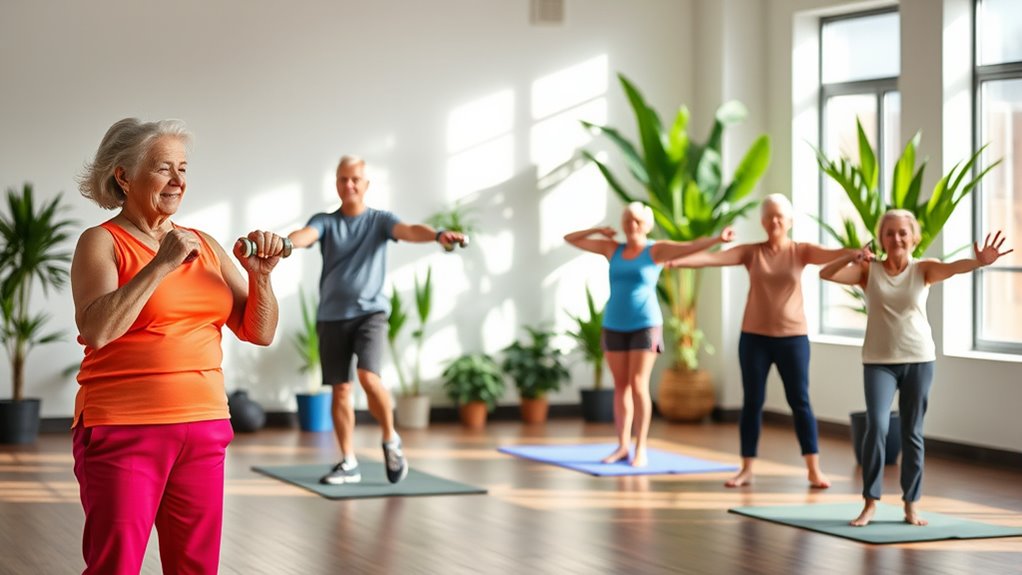
Incorporating balance and flexibility exercises into your routine can be a game-changer for maintaining mobility and preventing falls as you age.
These practices not only enhance your physical fitness but also improve functional mobility in daily activities.
Here are four key benefits to evaluate:
- Balance exercises, like single-leg stands and tai chi, improve stability and coordination, markedly reducing the risk of falls.
- Flexibility exercises, such as gentle stretching, enhance your range of motion in joints.
- Regular practice of both can improve posture, lowering the likelihood of back pain.
- Engaging in these exercises two to three times a week boosts your confidence in movement, encouraging you to stay active and involved in your community.
Frequently Asked Questions
What Is the Number One Exercise for Seniors?
The number one exercise for seniors is the squat. It enhances your leg strength, balance, and mobility, making daily activities like standing up or climbing stairs easier.
You can perform squats using just your body weight or with added resistance to gradually increase intensity as you get stronger. Aim for 10 to 15 repetitions in proper form, completing three sets.
If needed, try chair squats to guarantee safety and accommodate your fitness level.
What Is the 6 12 25 Rule?
The 6 12 25 Rule is a guideline for strength training that helps you structure your workouts effectively.
It suggests performing six different exercises, each with twelve repetitions, while focusing on maintaining good form. This approach targets major muscle groups, enhancing your overall strength and functional fitness.
You can adjust the weights and repetitions based on your fitness level, ensuring a safe and effective workout that promotes muscle growth and combats age-related decline.
What Is the Best Strength Training for a 70 Year Old?
Think of your body as a sturdy tree—strong roots keep it standing tall.
For a 70-year-old, the best strength training includes bodyweight exercises and light weights, like chair squats and wall push-ups. You’ll want to aim for 10 to 15 repetitions in three sets, adding resistance bands for variety.
Don’t forget balance exercises too, like single-leg stands, to keep your tree steady and firm against the winds of aging.
Always consult your doctor first.
What Is the Number 1 Exercise to Increase Balance in Seniors?
The number one exercise to increase balance in seniors is the single-leg balance exercise.
You can do this by standing on one leg for 10 to 30 seconds, then switching to the other leg. If you need support, hold onto a chair or wall.
Practicing this regularly, about 2-3 times a week, can greatly enhance your stability and coordination, reducing your risk of falls and promoting greater independence in daily activities.
Conclusion
Incorporating strength training into your daily routine can greatly enhance your quality of life. Did you know that just two sessions of strength training per week can reduce the risk of falls by up to 40%? By committing to these exercises, you’re not only building muscle but also boosting your confidence and independence. So, grab those weights and get started—your body will thank you, and you’ll thrive every day!


